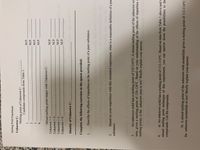
Chemistry
10th Edition
ISBN: 9781305957404
Author: Steven S. Zumdahl, Susan A. Zumdahl, Donald J. DeCoste
Publisher: Cengage Learning
expand_more
expand_more
format_list_bulleted
Question
thumb_up100%

Transcribed Image Text:**Melting Point Experiment**
**Unknown C:**
**Melting Point of Unknown C:**
- M.P.: __________
- M.P.: __________
- M.P.: __________
- M.P.: __________
**Candidate Compounds from Table 1:**
1. __________
2. __________
3. __________
4. __________
**Mixed Melting Point Ranges with Unknown C:**
- Unknown + 1:
- M.P.: __________
- Unknown + 2:
- M.P.: __________
- Unknown + 3:
- M.P.: __________
- Unknown + 4:
- M.P.: __________
**Identity of Unknown C:**
---
**Complete the following exercises in the spaces provided:**
1. Describe the effects of impurities on the melting point of a pure substance.
2. Based on your experience with this simulated experiment, what is a reasonable definition of a pure substance?
3. An unknown solid has a melting point of 132-135°C. A mixed melting point of the unknown with urea gives a melting point of 120-126°C. Based on your understanding of the effects of impurities on melting points, is the unknown urea or not? Briefly explain your answer.
4.
a) An unknown solid has a melting point of 112-114°C. Based on data from Table 1 above and the mixed melting point technique of this experiment, you can narrow down the possibilities to three compounds; list the compounds.
b) A mixed melting point of the unknown with acetanilide gives a melting point of 113-114°C. Is the unknown acetanilide or not? Briefly explain your answer.
Expert Solution
This question has been solved!
Explore an expertly crafted, step-by-step solution for a thorough understanding of key concepts.
This is a popular solution
Trending nowThis is a popular solution!
Step by stepSolved in 4 steps

Knowledge Booster
Learn more about
Need a deep-dive on the concept behind this application? Look no further. Learn more about this topic, chemistry and related others by exploring similar questions and additional content below.Similar questions
- 10.10 I already matched the firs 3.arrow_forwardAa.17.arrow_forward10 F4 Part D S A solution formed by mixing 13.0 mL of 0.130 M HBr with 24.0 mL of 0.200 MHCI Express your answer using three decimal places. pH = Provide Feedback Submit H R F5 % 5 ΑΣΦ Request Answer F6 T < 60 F7 F8 & 7 ? с F9 a F10 F11 :6: 00 Karrow_forward
- Nonearrow_forwardPreparation of 0.25N NaOH Objective: Apparatus and Materials: Procedure : Calculate the exact mass of NaOH needed to prepare 1.0L of 0.25N NaOH for standardization. Show your computations. Using the triple beam balance, weigh the desired amount of NaOH. Place the weighed amount of NaOH into the 500 mL volumetric flask and add distilled water until it reaches the mark. Agitate and transfer the solution into the reagent bottle. Add again distilled water to the same volumetric flask until it reaches the mark and pour it to the same reagent bottle, thus having a total volume of 1.0 L. Label the reagent bottle, 0.25N NaOH. Data and Computations: Conclusion:arrow_forward
arrow_back_ios
arrow_forward_ios
Recommended textbooks for you
 ChemistryChemistryISBN:9781305957404Author:Steven S. Zumdahl, Susan A. Zumdahl, Donald J. DeCostePublisher:Cengage Learning
ChemistryChemistryISBN:9781305957404Author:Steven S. Zumdahl, Susan A. Zumdahl, Donald J. DeCostePublisher:Cengage Learning ChemistryChemistryISBN:9781259911156Author:Raymond Chang Dr., Jason Overby ProfessorPublisher:McGraw-Hill Education
ChemistryChemistryISBN:9781259911156Author:Raymond Chang Dr., Jason Overby ProfessorPublisher:McGraw-Hill Education Principles of Instrumental AnalysisChemistryISBN:9781305577213Author:Douglas A. Skoog, F. James Holler, Stanley R. CrouchPublisher:Cengage Learning
Principles of Instrumental AnalysisChemistryISBN:9781305577213Author:Douglas A. Skoog, F. James Holler, Stanley R. CrouchPublisher:Cengage Learning Organic ChemistryChemistryISBN:9780078021558Author:Janice Gorzynski Smith Dr.Publisher:McGraw-Hill Education
Organic ChemistryChemistryISBN:9780078021558Author:Janice Gorzynski Smith Dr.Publisher:McGraw-Hill Education Chemistry: Principles and ReactionsChemistryISBN:9781305079373Author:William L. Masterton, Cecile N. HurleyPublisher:Cengage Learning
Chemistry: Principles and ReactionsChemistryISBN:9781305079373Author:William L. Masterton, Cecile N. HurleyPublisher:Cengage Learning Elementary Principles of Chemical Processes, Bind...ChemistryISBN:9781118431221Author:Richard M. Felder, Ronald W. Rousseau, Lisa G. BullardPublisher:WILEY
Elementary Principles of Chemical Processes, Bind...ChemistryISBN:9781118431221Author:Richard M. Felder, Ronald W. Rousseau, Lisa G. BullardPublisher:WILEY

Chemistry
Chemistry
ISBN:9781305957404
Author:Steven S. Zumdahl, Susan A. Zumdahl, Donald J. DeCoste
Publisher:Cengage Learning

Chemistry
Chemistry
ISBN:9781259911156
Author:Raymond Chang Dr., Jason Overby Professor
Publisher:McGraw-Hill Education

Principles of Instrumental Analysis
Chemistry
ISBN:9781305577213
Author:Douglas A. Skoog, F. James Holler, Stanley R. Crouch
Publisher:Cengage Learning

Organic Chemistry
Chemistry
ISBN:9780078021558
Author:Janice Gorzynski Smith Dr.
Publisher:McGraw-Hill Education

Chemistry: Principles and Reactions
Chemistry
ISBN:9781305079373
Author:William L. Masterton, Cecile N. Hurley
Publisher:Cengage Learning

Elementary Principles of Chemical Processes, Bind...
Chemistry
ISBN:9781118431221
Author:Richard M. Felder, Ronald W. Rousseau, Lisa G. Bullard
Publisher:WILEY